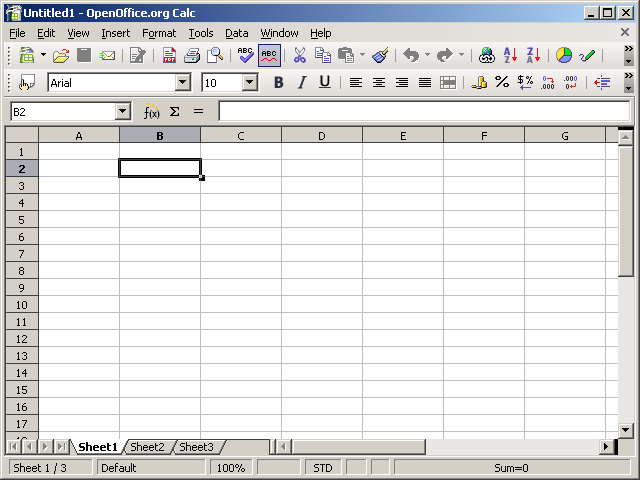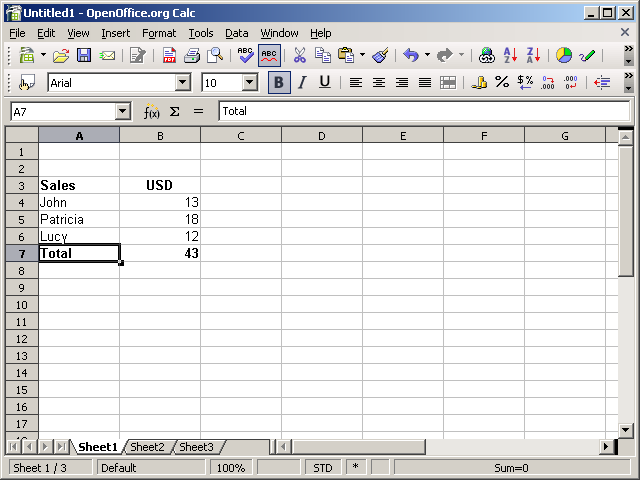
- •Оглавление
- •Introduction 2
- •Introducing Ms. Formula 10
- •Introduction Calc is a spread sheet -- what are those?
- •Open Sesame How to open a document
- •Save Me How to open a document
- •Close the Gates How to close a document
- •Introducing Ms. Formula An oversized calculator
- •Our first, real formula...
- •Average Joe The second formula
- •The time is now How to let Calc give you time
- •Extracting a given number of characters from a cells, counting from left
- •Extracting a given number of characters from a cells, counting from right
- •Extracting a given number characters, counting from the point you specify
- •How to create and use random numbers
- •How to look up values in a grid
- •How to round numbers
- •How to cut off decimals in an elegant way
- •How to sum only lines meeting your criteria
- •Vlookup(a1;b1:d100;3;0)
- •Vlookup(a1;b1:d100;3;0)
- •How to count characters in a cell or string
- •Formatting of text and cells How to change the appearance of the spreadsheet easily
- •DataPilot How to manipulate huge amounts of data easily
- •Charts How to create simple charts
Оглавление
Introduction 2
Calc is a spread sheet -- what are those? 2
Open Sesame 4
How to open a document 4
Save Me 6
How to open a document 6
Close the Gates 9
How to close a document 9
Introducing Ms. Formula 10
An oversized calculator 10
Sum it up 13
Our first, real formula... 13
Average Joe 26
The second formula 26
The time is now 30
How to let Calc give you time 30
=LEFT() 32
Extracting a given number of characters from a cells, counting from left 32
=RIGHT() 36
Extracting a given number of characters from a cells, counting from right 36
=MID() 38
Extracting a given number characters, counting from the point you specify 38
=RAND() 41
How to create and use random numbers 41
=VLOOKUP() 43
How to look up values in a grid 43
=ROUND() 50
How to round numbers 50
=TRUNC() 52
How to cut off decimals in an elegant way 52
=SUMIF() 54
How to sum only lines meeting your criteria 54
=IF() 57
How to set conditions for your formulas 57
=LEN() 61
How to count characters in a cell or string 61
Formatting of text and cells 63
How to change the appearance of the spreadsheet easily 63
DataPilot 71
How to manipulate huge amounts of data easily 71
Charts 77
How to create simple charts 77
Introduction 2
Calc is a spread sheet -- what are those? 2
Open Sesame 4
How to open a document 4
Save Me 6
How to open a document 6
Close the Gates 9
How to close a document 9
Introducing Ms. Formula 10
An oversized calculator 10
Sum it up 13
Our first, real formula... 13
Average Joe 26
The second formula 26
The time is now 30
How to let Calc give you time 30
=LEFT() 32
Extracting a given number of characters from a cells, counting from left 32
=RIGHT() 36
Extracting a given number of characters from a cells, counting from right 36
=MID() 38
Extracting a given number characters, counting from the point you specify 38
=RAND() 41
How to create and use random numbers 41
=VLOOKUP() 43
How to look up values in a grid 43
=ROUND() 50
How to round numbers 50
=TRUNC() 52
How to cut off decimals in an elegant way 52
=SUMIF() 54
How to sum only lines meeting your criteria 54
=IF() 57
How to set conditions for your formulas 57
=LEN() 61
How to count characters in a cell or string 61
Formatting of text and cells 63
How to change the appearance of the spreadsheet easily 63
DataPilot 71
How to manipulate huge amounts of data easily 71
Charts 77
How to create simple charts 77
Introduction Calc is a spread sheet -- what are those?
First
of all, let’s look at what you can do with a spread sheet. You can
use it as a calculator, make invoices, makes budgets, create lists,
make an analysis tool for evalating odds etc., etc., etc... The
possibilities are infinite.
A spread sheet is basically a
bunch of cells aligned horizontally and vertically.
In
each of these cells you can but different kinds of information.
Examples:
- numbers
- text
- formulas
Numbers
are entered both as information and as basis for formulas. "Text?
Isn't that for word processors?". Yes. And no. You wouldn't want
to use a spread sheet for heavy word processing, but you could use a
spread sheet to describe the numbers or formulas you have in y our
spread sheet.
"Text?
Isn't that for word processors?". Yes. And no. You wouldn't want
to use a spread sheet for heavy word processing, but you could use a
spread sheet to describe the numbers or formulas you have in y our
spread sheet.  Formulas;
this is where the magic lies... Most formulas are easy to use, some
are a little less easy to use and some are almost easy to use ;-) You
use formulas to change a bunch of data into something more useful,
such as a sum, or to count the numbers you have entered, or the
average of number etc.
An example; if you have a list of
20 numbers, you can, literally, in a matter of seconds find both the
sum of them, the average, the largest number AND the smallest number.
Not impressed? You feel you could do that without formulas? Of course
you can. But what if you have 200 numbers in the list? You would
still use the same formulas AND use the same amount of time to get
the numbers mentioned! Still not convinced? OK -- try 20.000 numbers
in a list. Done in the same amount of time. Try that on a
calculator.
OK, so some good news. The above example is
from the real world, and it's true! And it's fairly easy to
accomplish. The best news is that you'll know how in an hour or so...
Formulas;
this is where the magic lies... Most formulas are easy to use, some
are a little less easy to use and some are almost easy to use ;-) You
use formulas to change a bunch of data into something more useful,
such as a sum, or to count the numbers you have entered, or the
average of number etc.
An example; if you have a list of
20 numbers, you can, literally, in a matter of seconds find both the
sum of them, the average, the largest number AND the smallest number.
Not impressed? You feel you could do that without formulas? Of course
you can. But what if you have 200 numbers in the list? You would
still use the same formulas AND use the same amount of time to get
the numbers mentioned! Still not convinced? OK -- try 20.000 numbers
in a list. Done in the same amount of time. Try that on a
calculator.
OK, so some good news. The above example is
from the real world, and it's true! And it's fairly easy to
accomplish. The best news is that you'll know how in an hour or so...
